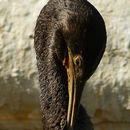Biology
(
英語
)
由Arkive提供
A highly gregarious species, the Socotra cormorant lives, breeds and often forages in enormous, dense colonies of up to tens of thousands (2) (5). While this bird is primarily sedentary, large seasonal movements are made within the breeding range, which are thought to be related to fish migrations (2) (5). Large assemblies of birds roam far in search of huge shoals of fish. Once found, some birds settle on the water's surface and dive for fish from there, whilst others plunge-dive from the air (5).
Very little information currently exists on the breeding behaviour of this bird. The northern population mostly nests during the winter months, while the southern population breeds in summer. Nests are packed close together within the colony, and comprise a circular scrape or depression in the ground with raised edges, concreted with excrement. Close proximity of nests inevitably results in much conflict and 'bickering' between neighbours, with returning birds frequently descending upon the wrong nest by accident and being chased off by the rightful owner. The incubation period is unknown, but thought to be around 28 days (5). At some stage of growth, parents leave their chicks in 'crèches' while they go out to forage, where they are guarded by a few adult birds from predation by large gulls (Larus spp.) (2) (5). Chicks are fed by partial regurgitation, after aggressively demanding food from their parents. Time to fledging is also unknown, but is probably somewhere around two months. Adult plumage is thought to be attained by the third year, but the age at which first breeding occurs is unknown (5).
Conservation
(
英語
)
由Arkive提供
The Socotra cormorant is protected across most of its range, but not in UAE. Some breeding sites have been specifically protected, but the sites of several more colonies desperately require the same protected status (2). In 2004, Dubai Zoo was the first institution in the world to successfully breed this rare bird in captivity. The objective was to release the chicks a year later at a pond in one of the city's parks where they would initially be fed with fish, with the hope that they would later fly towards the nearby Gulf waters to live in the wild (6). If successful, captive breeding and reintroduction programmes may be a viable conservation measure in the future if numbers in the wild should fall too low. Hopefully, however, it will never reach that stage. The Socotra cormorant is undoubtedly one of the treasures of the beautiful desert islands off the Arabian Peninsular, which are home to a rich array of unique wildlife, and as such are surely worthy of international recognition and greater protection (5).
Description
(
英語
)
由Arkive提供
The enormous colonies of Socotra cormorants form a spectacular sight. With their primarily black plumage, black bill, and black legs, the mass of jostling black shapes almost appear like a single moving organism, blanketing and enveloping the sandy bays on which they live. At the start of the breeding season, adult Socotra cormorants are in peak condition, sporting an extra glossy black plumage on their head, neck, rump and underparts (5). The back and wings are a shiny dark bronze-green colour, and during the breeding season, fine, white flecks appear on the neck of both sexes (2) (5).
Habitat
(
英語
)
由Arkive提供
The Socotra cormorant is an exclusively marine bird, which breeds only on flat-shored desert islands (2).
Range
(
英語
)
由Arkive提供
This large bird has an extremely restricted range, with two subpopulations now breeding at a total of just nine locations (5). The northern population breeds on islands off the Persian Gulf coasts of Bahrain, United Arab Emirates (UAE), Saudi Arabia, Qatar and possibly the Islamic Republic of Iran (breeding not confirmed since 1972) (2) (5). The much smaller southern population breeds on one or more islands off the Arabian Sea coast of Oman and in the Gulf of Aden off Yemen (2).
Status
(
英語
)
由Arkive提供
Classified as Vulnerable (VU) on the IUCN Red List 2006 (1) and listed on Appendix II of the Convention on Migratory Species (CMS) (3). It is also listed on Annex II of the African-Eurasian Waterbird Agreement (AEWA) (4).
Threats
(
英語
)
由Arkive提供
The relatively large but extremely restricted population of Socotra cormorants is primarily threatened by the fast pace of coastal development on its breeding islands for residential and tourist use, which is disturbing and displacing many colonies (2) (6). Human disturbance can cause parents to abandon their eggs and chicks, leaving them vulnerable and exposed to wide-scale predation by gulls (2). This bird's already threatened status is exacerbated by marine oil spills; the Socotra cormorant is probably the most commonly found oiled dead bird around the Bahrain coastline (5). Fisheries also pose a possible threat through reducing the species' food availability. Additional potential threats include introduced predators on breeding islands, the harvesting of chicks for food, persecution and ectoparasites (2).

